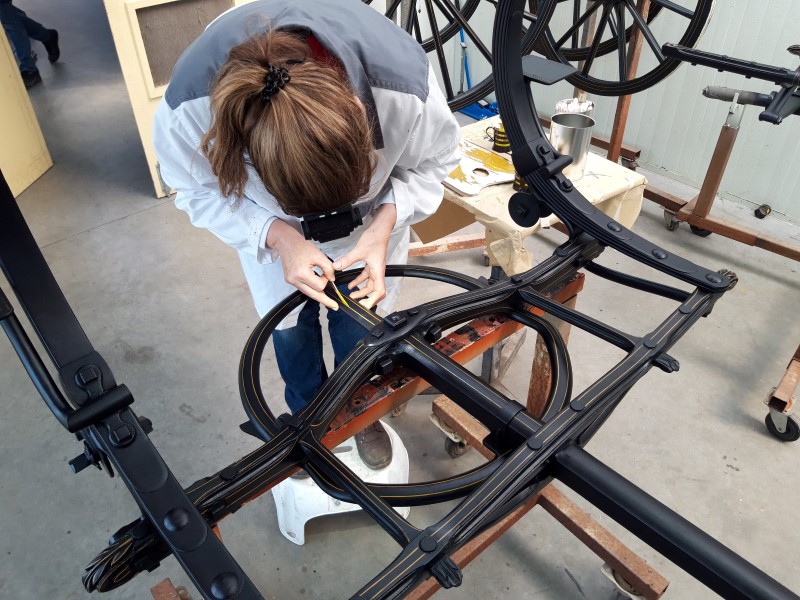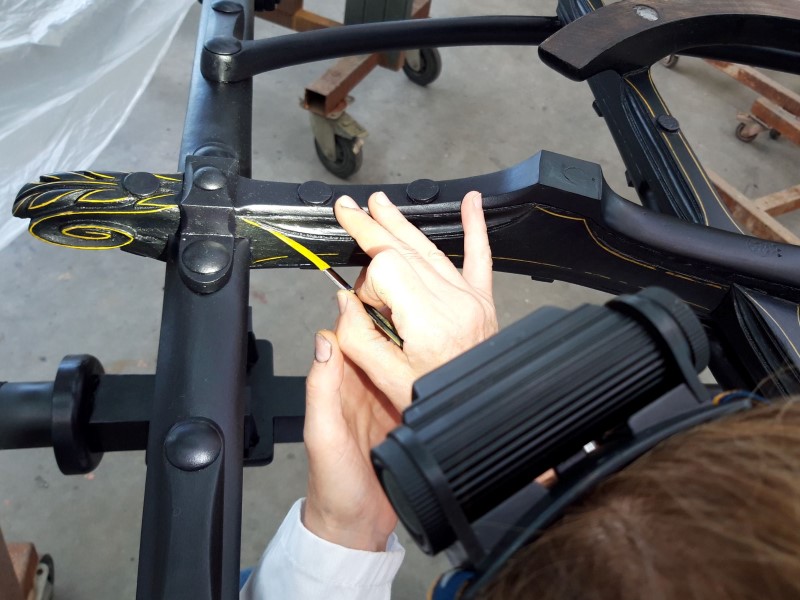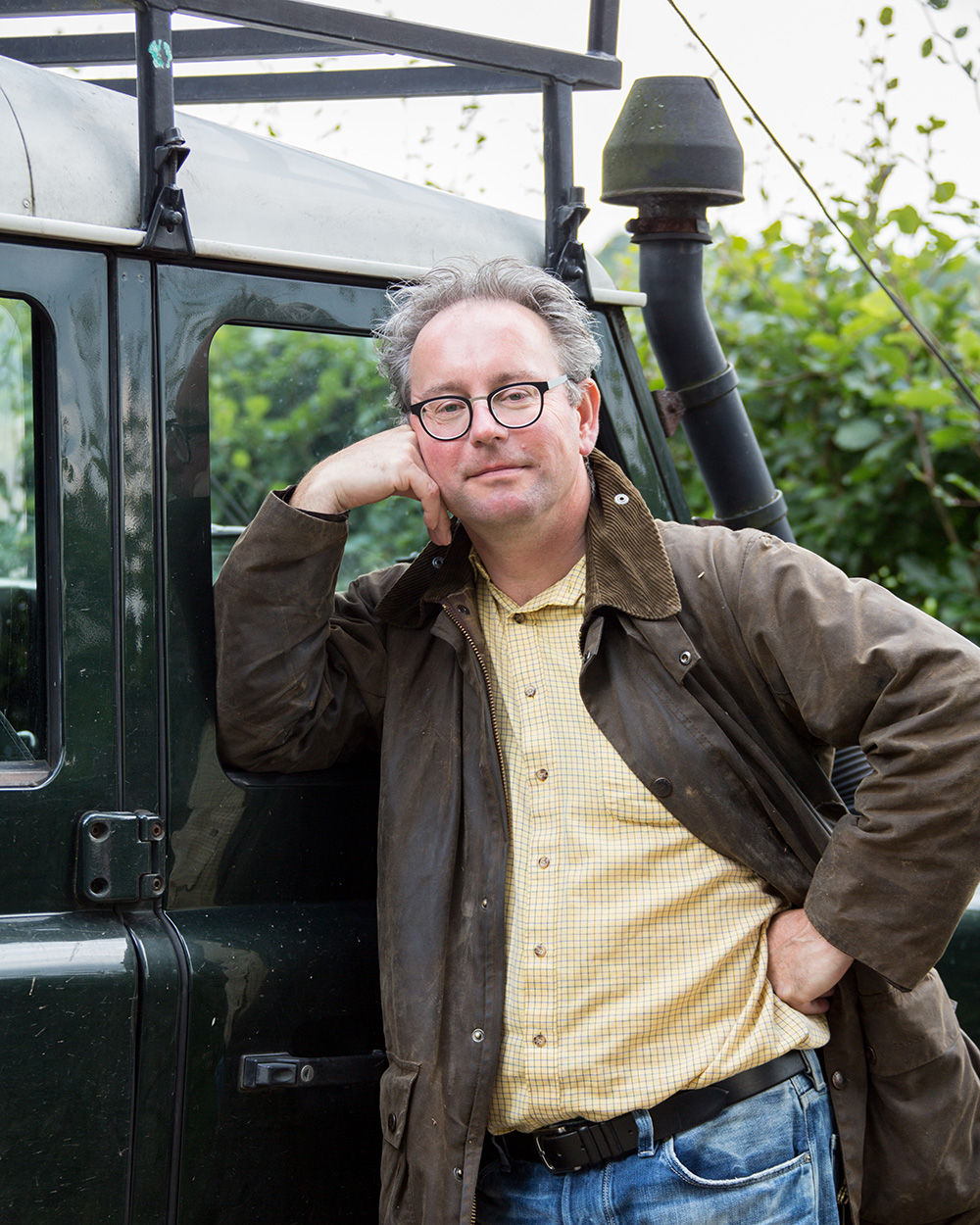Squirrel hair sword brush (part 3)
By: Mario Broekhuis
It has been quiet for a while around the Grand Duc, Castle de Haar's second carriage in the restoration workshop. That had everything to do with the meticulous cleaning of the old layers. By now, as we follow the process step by step, that is no longer so exciting for us. On large parts of the undercarriage, the paint had completely disappeared. Those parts have been repainted in an inconspicuous Prussian blue. And now things are about to get exciting again: Maria Stolk takes out her brushes to reconstruct the rush pattern.


Ho-ho, "tassels" is a totally wrong expression, the restorer calls out right away. It is a so-called sword brush made of squirrel hair, which she uses to draw the yellow lines on the base. "Here and there, where you can't get between them, I choose a long cowhair trencher," she says. She draws the stripes freehand. This is a great art, not only to draw the dashes perfectly straight, but also to keep them at the right distance from each other and to get an even thickness. A little miss gives an instant mess. You can imagine it vividly. It is a kind of caligraphy. But how does she prepare for this in terms of concentration? "You have to get into a flow of total emptiness and relaxation. And I have to squint a little, then it goes best. Skewing takes a lot of time. Sometimes you put them on one after another and then you get 'stuck' and it's like suddenly you can't do it anymore. Whenever I start it, I'm always wondering if I can still do it... And not only me, my colleagues too," Maria laughs warmly....
She is surprised that not so "extreme" is on the Grand Duc's undercarriage. "Now that they're on it, including all the old fragments and the whole thing completely visible again, it's extraordinary how modern the pattern is. I mean, for the time then."
The hardest part of this rush work is the color. Maria says, "Initially it has been a fierce shade of yellow, but in a restoration like this, where you leave the old paint in place and supplement it with new, you have to be very careful that the new doesn't become too fierce. You may not see directly from three feet away what has been added by the restorer. It took me a long time to create a color to match, from the basic dark chrome yellow. There is no such thing as "same color. Furthermore, for the expert in the future, it has to be visible what is authentic and what is supplemented. It's searching for the right balance."
After piping, the undercarriage gets what is called a final varnish, a protective coating. "Are we on schedule? I do keep an eye on it, but there's not much point in looking at it too much in between. There were a lot of square inches of cleaning in one wheel. I think we've had the worst of it."
The four carriages in this project come from the management of Borg and Nationaal Rijtuigmuseum Nienoord and are transferred to long-term loan by Kasteel De Haar. This project has been made possible in part by VZW Pater David, Prins Bernhard Cultuurfonds, Stichting Bonhomme Tielens, VSB Fonds, Mondriaan Fonds and Stichting kasteel de Haar. The Hippomobile Heritage Foundation is supervising the implementation and providing communication.
 Mario Broekhuis (51), a stewardship graduate, feels completely at home at a historic country estate like De Haar. Moreover, he knows alesson of carriagesand can tell wonderful stories about it. That is why Mario gives us a monthly update on the progress of the restoration of three carriages for De Haar on this page. The three carriages in this project come from the management of Borg and Nationaal Rijtuigmuseum Nienoord and are transferred to long-term loan by Castle de Haar. This project has been made possible by VZW Pater Davids, Prins Bernhard Cultuurfonds, VSBfonds, Stichting Bonhomme Tielens and Stichting kasteel de Haar. The Hippomobile Heritage Foundation is supervising the implementation and providing communication.
Mario Broekhuis (51), a stewardship graduate, feels completely at home at a historic country estate like De Haar. Moreover, he knows alesson of carriagesand can tell wonderful stories about it. That is why Mario gives us a monthly update on the progress of the restoration of three carriages for De Haar on this page. The three carriages in this project come from the management of Borg and Nationaal Rijtuigmuseum Nienoord and are transferred to long-term loan by Castle de Haar. This project has been made possible by VZW Pater Davids, Prins Bernhard Cultuurfonds, VSBfonds, Stichting Bonhomme Tielens and Stichting kasteel de Haar. The Hippomobile Heritage Foundation is supervising the implementation and providing communication.
